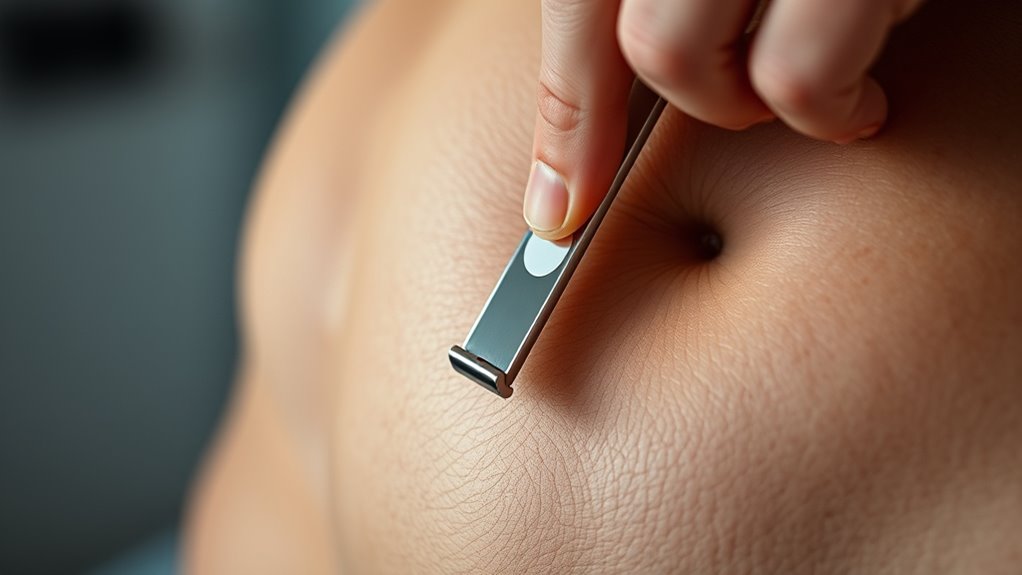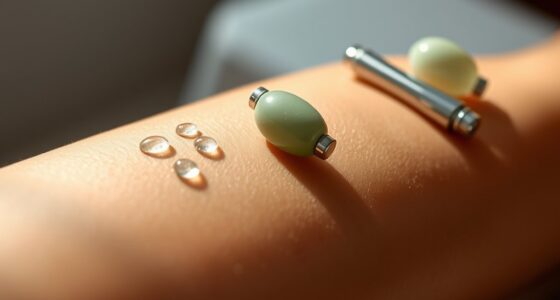When shaving sensitive areas, focusing on technique is more important than the tools you use. Always prepare your skin by softening hair and exfoliating to prevent ingrown hairs. Use a sharp razor and gentle, short strokes, shaving in the direction of hair growth. Tuck in your skin and stay gentle to avoid irritation and cuts. Ending with proper post-shave care helps soothe your skin. Keep these tips in mind to achieve a smoother, irritation-free shave—more helpful details follow.
Key Takeaways
- Focus on gentle, short strokes in the direction of hair growth to reduce irritation.
- Proper skin preparation, including exfoliation and dampness, minimizes cuts and ingrown hairs.
- Use a sharp, clean razor and suitable shaving products for smooth, safe gliding.
- Avoid shaving against the grain to prevent irritation and ingrown hairs.
- Follow with soothing, alcohol-free moisturizer to calm skin and promote healing.

Shaving sensitive areas requires careful attention because the skin in these regions is more delicate and prone to irritation. Unlike other parts of your body, these areas have thinner skin and a higher concentration of nerve endings, making them more susceptible to cuts, razor burn, and discomfort. That’s why technique often matters more than the tools you choose. Proper shaving technique can substantially reduce irritation and achieve a smoother, cleaner shave.
Start by preparing your skin thoroughly. Take a warm shower or bath to soften hair and open pores. This step makes hair removal easier and less traumatic for your skin. Gently exfoliate the area with a mild scrub or washcloth to remove dead skin cells. Exfoliation helps prevent ingrown hairs, which are common in sensitive areas, by freeing trapped hair. Pat the area dry with a soft towel, leaving it slightly damp, as shaving on damp skin reduces friction and irritation.
Prepare skin with warm water and gentle exfoliation for a smoother, irritation-free shave.
Use a sharp, clean razor—preferably a new one for each shave—to ensure a clean cut. Dull blades tug at hair rather than slicing it cleanly, increasing the risk of irritation and cuts. When you’re ready to shave, apply a generous amount of high-quality shaving gel or cream designed for sensitive skin. Avoid using soap or body wash, which can be drying and abrasive. The right product creates a protective barrier and allows the razor to glide smoothly over your skin.
Always shave with gentle, short strokes, moving in the direction of hair growth. Shaving against the grain might give a closer shave but can cause irritation and ingrown hairs in sensitive areas. Be especially cautious around curves and corners, taking your time to avoid nicks. Use your free hand to gently stretch the skin tight, creating a flatter surface for the razor. This reduces the chance of cuts and uneven patches.
After finishing, rinse the area with cool water to close pores and soothe the skin. Pat dry gently with a soft towel—don’t rub, as rubbing can cause irritation. Follow up with an alcohol-free, fragrance-free moisturizer or soothing lotion formulated for sensitive skin. Ingredients like aloe vera or witch hazel can help calm inflammation and prevent irritation post-shave.
Frequently Asked Questions
How Often Should I Shave My Sensitive Areas for Optimal Skin Health?
You should shave your sensitive areas every few days or when you notice stubble, but avoid daily shaving to prevent irritation. Focus on proper technique—use a sharp, clean razor, shave in the direction of hair growth, and avoid pressing too hard. Giving your skin time to recover between shaves helps prevent razor burns and ingrown hairs, ensuring your skin stays healthy and smooth.
Are There Specific Post-Shaving Care Tips for Sensitive Skin?
After shaving, you should gently rinse the area with cool water and pat it dry with a soft towel. Apply a fragrance-free, soothing moisturizer or aloe vera gel to reduce irritation and keep your skin hydrated. Avoid tight clothing and scratching the area. If you notice redness or bumps, consider using an over-the-counter hydrocortisone cream. These steps help minimize irritation and maintain healthy, smooth skin.
Can Shaving Too Frequently Cause Long-Term Skin Damage?
Shaving too often can be like wearing out a favorite pair of shoes; it wears down your skin over time. Yes, frequent shaving can cause long-term damage such as irritation, hyperpigmentation, or scars. To prevent this, give your skin time to recover, use proper technique, and avoid shaving over the same area repeatedly. Listening to your skin’s signals helps maintain its health and keeps it smooth and healthy in the long run.
What Are Common Signs of Irritation or Infection After Shaving?
You might notice redness, itching, or swelling after shaving, which are signs of irritation. Pimples, bumps, or pus could indicate infection. If your skin feels painful or warm to the touch, it’s a sign to take extra care. Sometimes, you may see dark spots or scarring if irritation persists. To prevent these issues, use proper technique, avoid shaving too often, and keep the area clean and moisturized.
Is It Safe to Shave Sensitive Areas if I Have Skin Conditions Like Eczema?
If you have eczema, shaving sensitive areas can be risky because it may worsen irritation or cause flare-ups. You should consult your dermatologist before shaving those areas. If your skin is healthy enough, use a gentle technique—like shaving in the direction of hair growth with a sharp, clean blade—and avoid harsh products. Always moisturize afterward to soothe your skin and reduce irritation risks.
Conclusion
Remember, mastering the technique is more important than relying on fancy tools when shaving sensitive areas. Proper preparation, gentle strokes, and patience reduce irritation and ingrown hairs. Some experts argue that the myth of needing the sharpest razor isn’t true; instead, a well-maintained blade and careful method do the job best. So, focus on your technique over tools, and you’ll achieve smoother, healthier skin without unnecessary fuss or discomfort.








